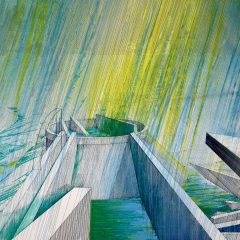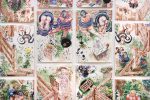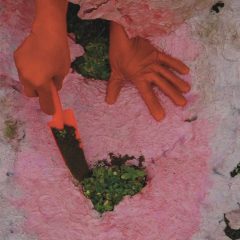Molly Hatch’s resume is a love letter to fine craft: with awards, teaching positions and accolades galore, she captures the zeitgeist of good design that’s become so prevalent in the last few years.
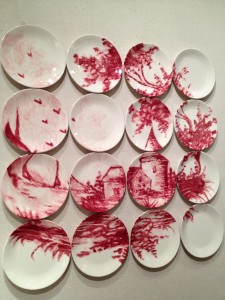
Hatch’s decorative plate exhibition, Reverie, combines gridworks of round plates on which the artist has painted a unified image, much as an artist might paint an image on a flat canvas. The patterns she uses for her imagery look old fashioned and the feel is that of stepping into another century. Fitting, as she’s recreated scenes from her Boston mercantile family’s own collection of dinnerware, accrued over generations.
Hatch studied the teacup collection of Francine and Sterling Clark at the Clark Art Institute in Williamstown, MA; curators there were instrumental in helping her devise her method of painting teacups with patterns that employed both their intricate surface designs and their silhouettes. You can see the same ideas in Reverie.
The plain-spoken, elegant body of work traverses the line between fine and decorative arts. In fact the ceramic plate ensembles have crossed into the commercial realm – they can be found for sale at Anthropologie. Seems the artist was “curated” by a savvy buyer who commissioned a housewares collaboration that exemplifies the store’s blend of homage to vintage goods and trend-tracking that many find so irresistible (good luck dragging me out of the sale racks before I’m ready).
Hatch’s project fits in cohesively with the Philadelphia Art Alliance’s domestic legacy —the building was once a private home. One additional domestic touch of Hatch’s is the wallpaper she’s made to accompany the plate paintings; it’s even named “Tea For Two.”
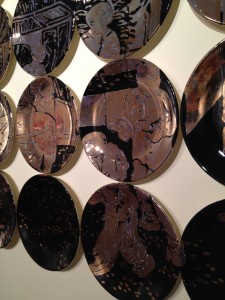
Hatch takes well to either an illustrative style or a more impressionistic one. After the Lacquer Box is a particularly luminous example of the way her interpretation of the plates’ images translates to the big picture. Glossy black and high gold make the swift brush strokes (depicting a scene from medieval China) pop.
Part sumptuous accents for a discerning decorator, and part genuine homage to a family trove in danger of being forgotten, “Reverie” is a milestone of Hatch’s career as a ceramics master and an excellent debut solo museum exhibition.
The Tool at Hand
The Tool At Hand opened the same night as Reverie, with the shared reception illuminating the similarities between the two. In this experimental exhibit, curator Dr. Ethan Lasser challenged sixteen artists from the US and Britain to make work using only one tool, and not their normal instrument of choice. The results, chronicled in a video by each artist and accompanied by the wildly different works they came up with, are quite the head trip.
Chad Curtis, the show’s Philadelphia artist, takes the fascination with abstract tools to its logical conclusion; his tool of choice is data. Curtis (who’s previously shown at the Art Alliance, with Speculative Landscapes in 2011) used data-derived templates to read of live data taken from the hourly radiation levels generated after the 2011 Tohoku earthquake and tsunami and resulting nuclear meltdown at Fukushima Daichi Nuclear Power Plant in Japan. Using the data and 3D modeling software to determine circumferences, he constructed eight spheres that he then built into plastic, lathe-turned objects, turning an abstract event into a tangible – and disturbingly so – reality.
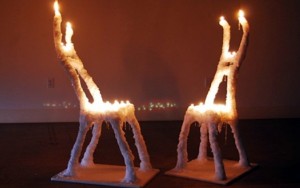
Hongtao Zhou used his hands to melt wax which he then used to sculpt Burniture, a chair designed to melt from overuse. That something already looking so haphazard and decomposing has a proscribed use is quite funny.
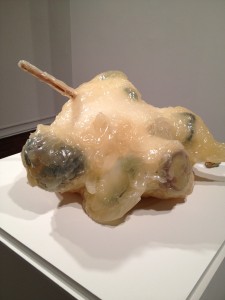
Tool: Caulk gun
“Gift Bowl,” by Beth Lipman, is another one that provokes levity. With the bulky carapace created by her caulk gun, this alien-looking concoction of found objects and polyurethane hardly resembles the kind of gift most people would consider a welcome accent to their home, but it’s magnetic nonetheless.
Helen Carnac is fascinated by residual things, the odds and ends that turn up when she goes for walks. Found, Recorded, Relayed, consisting of prints on paper and found objects, is accompanied by her video, which starts in silence and then is punctuated by a repeated, harsh clatter of a metal sheet being dropped next to her rolling mill, as if to punctuate the question of her objects’ origins.

It’s interesting to observe how many of the artists chose tools only tangentially related to what they do in “real life,” like Caroline Slotte’s use of a utility knife with which to etch ceramic and plastic cups. On the other hand, Liz Collins took this as an opportunity to allay her feelings of limitation with hand-sewing to use a knitting machine for her piece, pushing it past its normal use in the process. Her video reveals an almost spiritual experience, the knitting machine invoking a kind of trance, necessitated by the attention to detail. “Being confined is strangely liberating,” the subtitle reads, and you might as well make that the modus operandi for the entire show.
There’s a common denominator of craftsmanship in everything we consume, from our electronics to our furniture to our business cards. Everyone’s a curator or a tastemaker, whether they use ceramics to express a contemporary sensibility like Hatch or a single unlikely instrument to discover new facets of their creative side like the artist-participants of the Tool at Hand.
Reverie and the Tool at Hand are at the Philadelphia Art Alliance until April 28. Hours 11-5 PM Tues-Fri, 12-5 Sat-Sun. Closed Mondays.


